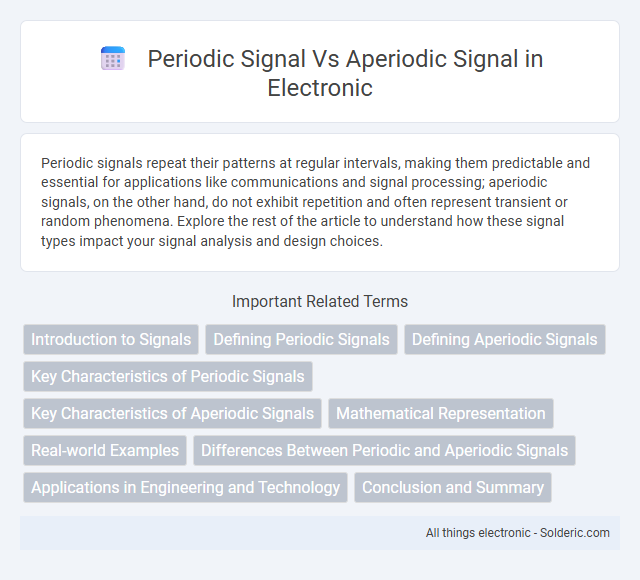Periodic signals repeat their patterns at regular intervals, making them predictable and essential for applications like communications and signal processing; aperiodic signals, on the other hand, do not exhibit repetition and often represent transient or random phenomena. Explore the rest of the article to understand how these signal types impact your signal analysis and design choices.
Comparison Table
| Feature | Periodic Signal | Aperiodic Signal |
|---|---|---|
| Definition | Repeats at regular intervals over time | Does not repeat, occurs randomly or once |
| Time Domain | Signal x(t) satisfies x(t) = x(t + T), T = period | No fixed period, x(t) x(t + T) for any T |
| Frequency Spectrum | Discrete spectral lines at multiples of fundamental frequency | Continuous spectrum over frequency range |
| Examples | Sine wave, square wave, sawtooth wave | Impulse, noise, transient signals |
| Energy | Infinite energy (non-decaying) | Finite energy signals |
| Fourier Transform | Fourier Series representation | Continuous Fourier Transform |
Introduction to Signals
Periodic signals repeat their patterns consistently over regular intervals, characterized by fundamental frequency and harmonics, making them essential in applications like communication systems and signal processing. Aperiodic signals lack this repetition, exhibiting non-repeating waveforms with continuous frequency spectra, commonly found in transient or random phenomena. Understanding these distinctions is crucial for signal analysis, synthesis, and filtering in electrical engineering and applied physics.
Defining Periodic Signals
Periodic signals repeat their pattern at regular intervals over time, characterized by a fundamental period T, which defines the duration after which the signal repeats. These signals are mathematically expressed as x(t) = x(t + nT), where n is an integer, ensuring consistency in waveform and frequency components. Understanding periodic signals enables you to analyze and predict signal behavior in various applications such as communication systems and signal processing.
Defining Aperiodic Signals
Aperiodic signals lack a repeating pattern over time, making them non-periodic and typically transient or random in nature. Unlike periodic signals, which have a fixed fundamental frequency and repeat at regular intervals, aperiodic signals do not exhibit this regularity and often possess a continuous frequency spectrum. Examples include impulse signals, noise, and speech segments, where signal characteristics vary unpredictably without consistent repetition.
Key Characteristics of Periodic Signals
Periodic signals exhibit a repetitive pattern that recurs at regular intervals defined by the fundamental period, enabling consistent frequency components identifiable through Fourier series representation. Their time-domain waveform repeats identically, allowing for precise analysis in signal processing applications such as communications and control systems. Key characteristics include a well-defined fundamental frequency, harmonic content at integer multiples of this frequency, and predictable phase relationships, which differentiate them from aperiodic signals lacking such repetition and frequency regularity.
Key Characteristics of Aperiodic Signals
Aperiodic signals lack a repetitive pattern and do not exhibit a fixed time interval, distinguishing them from periodic signals that repeat consistently. They often have non-zero energy only over finite durations and exhibit broad frequency spectra, making them essential in transient signal analysis. Understanding the key characteristics of aperiodic signals helps you accurately process and analyze real-world signals such as speech and radar pulses.
Mathematical Representation
Periodic signals are mathematically represented by functions that repeat at regular intervals, typically expressed as x(t) = x(t + T), where T is the fundamental period. Their Fourier series decomposition provides a sum of sinusoidal components with discrete frequencies corresponding to integer multiples of the fundamental frequency. Aperiodic signals lack such repetition and are represented using Fourier transform, resulting in a continuous spectrum rather than discrete frequency components.
Real-world Examples
Periodic signals, such as the consistent oscillations of a heart monitor or the steady tone of a musical note, repeat at regular intervals, making them ideal for applications in telecommunications and control systems. Aperiodic signals, like human speech or earthquake tremors, lack regular repetition, reflecting their unpredictable and transient nature crucial for voice recognition and seismology analysis. Understanding the distinction between these signals helps you accurately analyze and process real-world data in engineering and scientific research.
Differences Between Periodic and Aperiodic Signals
Periodic signals repeat at regular intervals, characterized by a fixed fundamental frequency and harmonic components, making them predictable and easy to analyze using Fourier series. Aperiodic signals lack this repetition, exhibiting non-repetitive patterns with continuous spectra, which require Fourier transform for analysis. Understanding these differences helps you choose appropriate signal processing techniques for communications or control systems.
Applications in Engineering and Technology
Periodic signals are extensively used in communication systems, signal processing, and control engineering due to their predictable frequency components that simplify filtering and modulation. Aperiodic signals play a crucial role in transient analysis, random signal processing, and biomedical engineering where non-repetitive or time-varying signals must be analyzed for system responses and diagnosis. Both signal types are fundamental in designing electronic circuits, radar systems, and audio engineering for accurately interpreting and manipulating diverse real-world signals.
Conclusion and Summary
Periodic signals repeat at regular intervals, making them predictable and suitable for applications like communication and signal processing. Aperiodic signals lack this repetition, requiring different analysis techniques such as Fourier transforms to understand their frequency components. Understanding the distinction helps you choose appropriate methods for accurate signal representation and processing.
periodic signal vs aperiodic signal Infographic

 solderic.com
solderic.com